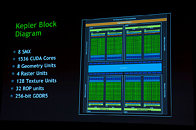- Joined
- Oct 9, 2007
- Messages
- 47,849 (7.39/day)
- Location
- Dublin, Ireland
| System Name | RBMK-1000 |
|---|---|
| Processor | AMD Ryzen 7 5700G |
| Motherboard | Gigabyte B550 AORUS Elite V2 |
| Cooling | DeepCool Gammax L240 V2 |
| Memory | 2x 16GB DDR4-3200 |
| Video Card(s) | Galax RTX 4070 Ti EX |
| Storage | Samsung 990 1TB |
| Display(s) | BenQ 1440p 60 Hz 27-inch |
| Case | Corsair Carbide 100R |
| Audio Device(s) | ASUS SupremeFX S1220A |
| Power Supply | Cooler Master MWE Gold 650W |
| Mouse | ASUS ROG Strix Impact |
| Keyboard | Gamdias Hermes E2 |
| Software | Windows 11 Pro |
Specifications sheets of NVIDIA's GK104 GPU left people dumbfounded at the CUDA core count, where it read 1536, a 3-fold increase over that of the GeForce GTX 580 (3x 512). The block-diagram of the GK104, photographed at the NVIDIA press-meet by an HKEPC photographer, reveals how it all adds up. The GK104 is built on 28 nm fab process, with a die area of around 295 mm², according to older reports. Its component hierarchy essentially an evolution of that of the Fermi architecture.
The hierarchy starts with the GigaThread Engine, which marshals all the unprocessed and processed information between the rest of the GPU and the PCI-Express 3.0 system interface, below this, are four graphics processing clusters (GPCs), which holds one common resource, the raster engine, and two streaming multiprocessors (SMs), only this time, innovation has gone into redesigning the SM, it is called SMX. Each SMX has one next-generation PolyMorph 2.0 engine, instruction cache, 192 CUDA cores, and other first-level caches. So four GPCs of two SMXs each, and 16 SMXs of 192 CUDA cores each, amount to the 1536 CUDA core count. There are four raster units (amounting to 32 ROPs), 8 geometry units (each with a tessellation unit), and some third-level cache. There's a 256-bit wide GDDR5 memory interface.



View at TechPowerUp Main Site
The hierarchy starts with the GigaThread Engine, which marshals all the unprocessed and processed information between the rest of the GPU and the PCI-Express 3.0 system interface, below this, are four graphics processing clusters (GPCs), which holds one common resource, the raster engine, and two streaming multiprocessors (SMs), only this time, innovation has gone into redesigning the SM, it is called SMX. Each SMX has one next-generation PolyMorph 2.0 engine, instruction cache, 192 CUDA cores, and other first-level caches. So four GPCs of two SMXs each, and 16 SMXs of 192 CUDA cores each, amount to the 1536 CUDA core count. There are four raster units (amounting to 32 ROPs), 8 geometry units (each with a tessellation unit), and some third-level cache. There's a 256-bit wide GDDR5 memory interface.



View at TechPowerUp Main Site













